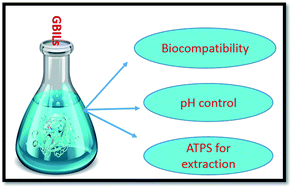Self-buffering and biocompatible ionic liquid based biological media for enzymatic research†
Abstract
In the present work, we have designed five new biocompatible, self-buffering ionic liquids (ILs) in which the cationic part is derived from conventional tetra-butylphosphonium (TBP) and the anionic part is derived from common biological buffers TAPS, MOPS, EPPS, CAPS, and BICINE. The new ionic liquid based biocompatible media ([TBP][TAPS], [TBP][MOPS], [TBP][EPPS], [TBP][CAPS], and [TBP][BICINE]) were found to be suitable for overcoming most of the problems associated with enzymatic research including optimum pH range, biocompatibility, and extraction. In comparison with the conventional ionic liquid based biological media, these new media do not involve an external buffering compound and maintain the optimum pH by their self-buffering capability. The buffering nature of these new ILs was confirmed by measuring their pH profiles and protonation constants in aqueous solutions at different temperatures. The biocompatibility of these new ILs was also confirmed by measuring the biological activity of the enzyme α-chymotrypsin (α-CT) in the aqueous media of these ILs. Moreover, these new ionic liquids can form an aqueous two phase system (ATPS) with a common inorganic salt such as sodium sulfate. The excellent extraction efficiency (100%) of these ionic liquid-based ATPS was observed for the extraction of enzyme α-CT, in its active form, in an IL-rich phase via a single stage extraction. Since the selected common biological buffers are biocompatible and nontoxic compounds, the ionic liquids derived from these buffer compounds could be more promising for biological research.


 Please wait while we load your content...
Please wait while we load your content...